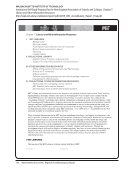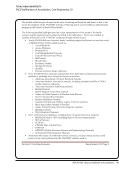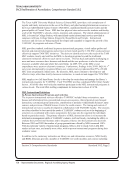SPEC Kit 330: Library Contribution to Accreditation · 125
University of Colorado at Boulder
Examples of University Libraries Evidence for Criteria 1, 3, 4, 5 of the North Central Association Higher
Learning Commission Requirements for Re-accreditation 2010
Core Component 5b: The organization has the capacity and the commitment to engage with its identified
constituencies and communities.
• The current renovation in Norlin is designed to foster more personalized and focused
connections between library staff and users, as well as among students and among students
and faculty. The first floor Learning Commons is a joint project of the Libraries and
Information Technology Services to create a learning library that integrates technology in a
flexible innovative design to support the continuum of learning. The campus Program for
Writing and Rhetoric is also integrated into the design for both space and service. The
second level Research Floor provides centralized services and space for individual
consultations, small group and classroom learning. The renovation is a direct response to
user demand.
• Changes in staffing and budget allocations are also direct responses to user demands for
enhanced and expanded electronic/digital resources.
• User requests for improved signage and communication are now met with the installation of a
digital sign system and more participation in campus online communication venues.
• Exhibits and events develop many campus and community connections. Recent examples
include several series of “dialog” events that were well attended by campus and community
members and involved community organizations and science and research institutions as well
as a variety of campus groups.
• Through the provision of online resources, the Libraries has dramatically expanded its user
base both off and on campus and virtually supported the larger community.
• The Libraries consistently highlights expanded engagement and service in planning activities.
Core Component 5c: The organization demonstrates its responsiveness to those constituencies that depend
on it for service.
• As a result of extensive and in-depth analyses of “selection to access” processes, the Libraries
adopted new technologies, implemented new work flow procedures, and revised relevant
policies in order to speed information resources to users.
• Through participation in OCLC and PCC, the Libraries contributes expertise to those national
and international databases, thus serving researchers worldwide.
• Collaborates with Writing Program to foster skill development on campus.
• Participates in and seeks representation from campus groups. Partners with the Office of
Faculty Affairs for Program Review in the Humanities and with the Graduate School and
Graduate Teacher Program to participate in the Provost’s Fellowship Program to encourage
graduate students to consider a career in research librarianship
• The Friends of the Libraries showcases resources to the community through its annual
Information Day and CU Treasures events among others, all of which are consistently and
highly attended by community members.
• The Libraries is a national leader in collaboration and partnership with other academic
libraries and consortia. Examples include: PASCAL, the Colorado Alliance of Research
Libraries (notably the shared collection development project), Prospector, national
Interlibrary Loan activity, partnership with Emporia Library School Diversity Initiative,
Great Western Library Association, Association of Research Libraries, and Center for
Research Libraries global projects
Core Component 5d: Internal and external constituencies value the services the organization provides.
University of Colorado at Boulder
Examples of University Libraries Evidence for Criteria 1, 3, 4, 5 of the North Central Association Higher
Learning Commission Requirements for Re-accreditation 2010
Core Component 5b: The organization has the capacity and the commitment to engage with its identified
constituencies and communities.
• The current renovation in Norlin is designed to foster more personalized and focused
connections between library staff and users, as well as among students and among students
and faculty. The first floor Learning Commons is a joint project of the Libraries and
Information Technology Services to create a learning library that integrates technology in a
flexible innovative design to support the continuum of learning. The campus Program for
Writing and Rhetoric is also integrated into the design for both space and service. The
second level Research Floor provides centralized services and space for individual
consultations, small group and classroom learning. The renovation is a direct response to
user demand.
• Changes in staffing and budget allocations are also direct responses to user demands for
enhanced and expanded electronic/digital resources.
• User requests for improved signage and communication are now met with the installation of a
digital sign system and more participation in campus online communication venues.
• Exhibits and events develop many campus and community connections. Recent examples
include several series of “dialog” events that were well attended by campus and community
members and involved community organizations and science and research institutions as well
as a variety of campus groups.
• Through the provision of online resources, the Libraries has dramatically expanded its user
base both off and on campus and virtually supported the larger community.
• The Libraries consistently highlights expanded engagement and service in planning activities.
Core Component 5c: The organization demonstrates its responsiveness to those constituencies that depend
on it for service.
• As a result of extensive and in-depth analyses of “selection to access” processes, the Libraries
adopted new technologies, implemented new work flow procedures, and revised relevant
policies in order to speed information resources to users.
• Through participation in OCLC and PCC, the Libraries contributes expertise to those national
and international databases, thus serving researchers worldwide.
• Collaborates with Writing Program to foster skill development on campus.
• Participates in and seeks representation from campus groups. Partners with the Office of
Faculty Affairs for Program Review in the Humanities and with the Graduate School and
Graduate Teacher Program to participate in the Provost’s Fellowship Program to encourage
graduate students to consider a career in research librarianship
• The Friends of the Libraries showcases resources to the community through its annual
Information Day and CU Treasures events among others, all of which are consistently and
highly attended by community members.
• The Libraries is a national leader in collaboration and partnership with other academic
libraries and consortia. Examples include: PASCAL, the Colorado Alliance of Research
Libraries (notably the shared collection development project), Prospector, national
Interlibrary Loan activity, partnership with Emporia Library School Diversity Initiative,
Great Western Library Association, Association of Research Libraries, and Center for
Research Libraries global projects
Core Component 5d: Internal and external constituencies value the services the organization provides.
























































































































































































